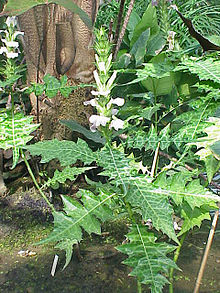Acanthus (plant)
| Acanthus | |
|---|---|
 |
|
| Acanthus montanus | |
| Scientific classification | |
| Kingdom: | Plantae |
| (unranked): | Angiosperms |
| (unranked): | Eudicots |
| (unranked): | Asterids |
| Order: | Lamiales |
| Family: | Acanthaceae |
| Subfamily: | Acanthoideae |
| Tribe: | Acantheae |
| Genus: |
Acanthus L. |
| Species | |
|
See text |
|
| Synonyms | |
|
Cheilopsis Moq. |
|
See text
Cheilopsis Moq.
Acanthus is a genus of about 30 species of flowering plants in the family Acanthaceae, native to tropical and warm temperate regions, with the highest species diversity in the Mediterranean Basin and Asia. Common names include Acanthus and Bear's breeches. The generic name derives from the Greek term for the Acanthus mollis, ἄκανθος, akanthos, a plant that was commonly imitated in Corinthian capitals.
The genus comprises herbaceous perennial plants, rarely subshrubs, with spiny leaves and flower spikes bearing white or purplish flowers. Size varies from 0.4 to 2 m (1.3 to 6.6 ft) in height.
Several species, especially A. balcanicus, A. spinosus and A. mollis, are grown as ornamental plants.
Acanthus leaves were the aesthetic basis for capitals in the Corinthian order of architecture; see acanthus (ornament).
![]() Chisholm, Hugh, ed. (1911). "". Encyclopædia Britannica (11th ed.). Cambridge University Press.
Chisholm, Hugh, ed. (1911). "". Encyclopædia Britannica (11th ed.). Cambridge University Press.
...
Wikipedia
